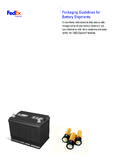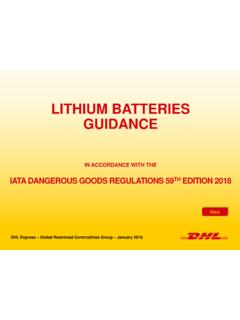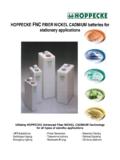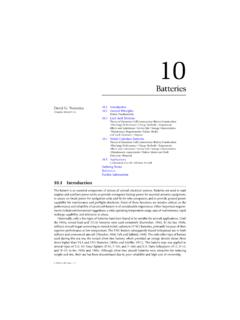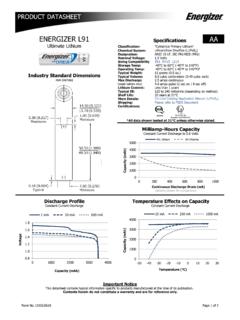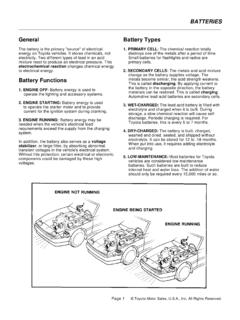Transcription of Characteristics of Rechargeable Batteries
1 Characteristics of Rechargeable BatteriesLiterature Number: SNVA533 IntroductionThis chapter will highlight the most important electrical and physical Characteristics ofthe three most popular chemistries used in Rechargeable Batteries : Nickel-Cadmium (Ni-Cd) Nickel Metal-Hydride (Ni-MH) Lithium-Ion (Li-Ion)Definitions of TermsA cell is an electro-chemical device capable of supplying the energy that results from aninternal chemical reaction to an external electric battery is composed of one or more cells, either parallel or series connected to obtaina required current/voltage capability ( Batteries comprised of series connected cells areby far the most common).
2 ESR (Equivalent Series Resistance) is the internal resistance present in any cell thatlimits the amount of peak current it can Amp-hour capacity of a battery (or cell) is its most important figure of merit: it isdefined as the amount of current that a battery can deliver for 1 hour before the batteryvoltage reaches the end-of-life "c" rate is a current that is numerically equal to the A-hr rating of the cell. Chargeand discharge currents are typically expressed in fractions or multiples of the c MPV (mid-point voltage) is the nominal voltage of the cell, and is the voltage that ismeasured when the battery has discharged 50% of its total measured cell voltage at the end of its operating life is called the EODV, whichstands for End of Discharge Voltage (some manufacturers refer to this as EOL or Endof Life voltage).
3 The gravimetric energy density of a battery is a measure of how much energy a batterycontains in comparison to its volumetric energy density of a battery is a measure of how much energy a batterycontains in comparison to its constant-voltage charger is a circuit that recharges a battery by sourcing only enoughcurrent to force the battery voltage to a fixed constant-current charger is a circuit that charges a battery by sourcing a fixed currentinto the battery, regardless of battery OF RECHARGEABLEBATTERIESC hester SimpsonNNational SemiconductorThe Charge/Discharge CurveThe measured terminal voltage of any battery will vary as it is charged and discharged(see Figure 1).
4 The MPV (mid-point voltage) is the nominal voltage of the cell during charge or dis-charge. The maximum and minimum voltage excursion from the nominal value is animportant design consideration: a "flatter" discharge curve means less voltage variationthat the design must tolerate. When peak charged, the actual cell voltage will be higher than the MPV. When nearingthe EODV (end of discharge voltage) point, the cell voltage will be less than the MPV. The EODV is sometimes referred to as the EOL (end of life) voltage by Battery CharacteristicsThe electrical Characteristics of a battery define how it will perform in the circuit, and thephysical properties have a large impact on the overall size and weight of the productthat it will key properties and specifications for Ni-Cd, Ni-MH, and Li-Ion will be presented foreasy Density (By Weight and Volume)The energy density of a battery is generally expressed in two ways (see Figure 2).
5 The gravimetric energy density of a battery is a measure of how much energy a batterycontains in comparison to its weight, and is typically expressed in Watt-hours/kilogram(W-hr/kg).The volumetric energy density of a battery is a measure of how much energy a batterycontains in comparison to its volume, and is typically expressed in Watt-hours/liter(W-hr/l).FIGURE 1. BATTERY CHARGE/DISCHARGE CURVECELL VOLTAGECHARGEDISCHARGETIMEMPVEODVIn reviewing the data in Figure 2, the Li-Ion advantage in gravimetric density is clearlythe most striking, almost doubling the Ni-Cd and Ni-MH figures. This means that products powered by Li-Ion cells can be made much lighter withoutsacrificing run time.
6 Alternately, if the battery weight is kept the same, the run time willdouble if Li-Ion Batteries are used. This fact explains the reason that Li-Ion is quicklydisplacing Ni-MH in top-of-the-line cellular phones and laptop Voltage/Voltage StabilityThe voltage provided to power the load is obviously very important: The Ni-Cd andNi-MH Batteries have a nominal cell voltage (their discharge voltages are gener-ally assumed to be identical). The Ni-Cd/Ni-MH cell voltage is only about one-third of the nominal provided by aLi-Ion cell (see Figure 3), which means a designer is required to use three series-connected Ni-Cd or Ni-MH cells to equal the voltage of a single Li-Ion cell.
7 However, Figure 3 also shows the biggest advantage of Ni-Cd and Ni-MH Batteries : their discharge curve is extremely flat, closest to an ideal important difference between the battery types means that Ni-Cd and Ni-MH cellsare well suited for use with linear regulators, but Li-Ion Batteries require switching con-verters to obtain good energy conversion efficiency in the power 2. ENERGY DENSITY COMPARISONCELL TYPENI-MHNI-CDLI-IONGRAVIMETRIC DENSITY (W-HR/KG)VOLUMETRIC DENSITY (W-HR/L)210180140905550 FIGURE 3. CELL DISCHARGE CURVECELL VOLTAGE (V)TIME (H)4312 3 45IL= VOLTAGE (V)TIME (H)NI-CD/NI-MHPeak Current The maximum current that a battery can deliver is directly dependent on the internalequivalent series resistance (ESR) of the current flowing out of the battery must pass through the ESR, which will reduce thebattery terminal voltage by an amount equal to the ESR multiplied times the load current(V = I X R).
8 More important, the current flowing through the ESR will cause power dissipation withinthe battery that is equal to the ESR multiplied times the current squared (P = I2 X R). This can result in significant heating within the battery at high rates of Ni-Cd and Ni-MH Batteries have extremely low ESR values (well below for atypical "AA" cell), which means that ESR is almost never a limitation for peak dischargecurrent in these cell Li-Ion battery will typically have a higher ESR (compared to Ni-Cd or Ni-MH), butwill probably not be a problem in most applications. Self DischargeSelf-discharge (which occurs in all Batteries ) determines the "shelf life" of a battery.
9 Figure 4 shows typical self-discharge rates for the three chemistries, exact values willvary with general, Li-Ion is the best of the lot, while Ni-Cd and Ni-MH are fairly comparable toeach other. Ni-Cd is typically a little better than Ni-MH, but this may even out as Ni-MHmanufacturing technology matures. It is important to note that self-discharge is highly dependent on temperature, increasingas the battery temperature is unpleasant characteristic (I have heard voiced with respect to Ni-MH batteriesused in cellular phones and laptop computers) is that the discharge rate is extremelynon-linear. A battery which loses 30% in a month may lose 15 to 20% in the first fewdays (not good if you are taking a couple of spare Batteries on a week-long trip, and youdon't want to carry the charging station).
10 CELL TYPENI-MHNI-CDLI-IONSELF-DISCHARGE@ 20 C (%/MONTH)5-1015-2020-30 FIGURE 4. RATES OF SELF DISCHARGER echarge TimeThe amount of time that the typical consumer finds acceptable for battery recharging ishighly variable, and depends on the item being powered. Figure 5 shows the typicalminimum charging times for slow and fast charging rates of the three battery CHARGING"Slow" charge is defined as a charging current that can be safely applied to a batteryindefinitely without any kind of monitoring or charge termination method (it is sometimesreferred to as trickle charging). A typical Ni-Cd battery will easily tolerate c/10, andsome fast-charge Ni-Cd cells will accept up to cells are not as tolerant of constant charging, as most will not handle a sustainedcharging current greater than c/40 (although one manufacturer advertises cells that arerated for c/10 trickle charge rate).










